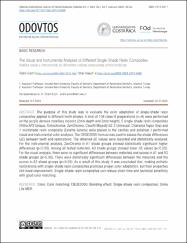The visual and instrumental analyses of different single-shade resin composites
Citation
Erçin, Ö.; Kopuz, D. The visual and instrumental analyses of different single-shade resin composites. Odovtos-International Journal of Dental Sciences (2024), 26(1) (January-April): 54-64.Abstract
The purpose of this study was to evaluate the color adaptation of single-shade resin composites applied to different tooth shades. A total of 108 class III preparations (n=6) were performed on the acrylic denture maxillary incisors (2mm depth and 2mm height). 5 single-shade resin composites (Vittra APS Unique, Omnichroma, ZenChroma, Clearfil Majesty ES-2 Universal, Charisma Topaz One) and 1 multishade resin composite (Estelite Asteria) were placed in the cavities and polished. I performed visual and instrumental color analyses. The CIEDE2000 formula was used to assess the shade differences (ΔE) between teeth and restorations. The obtained ΔE values were recorded and statistically analyzed. For the instrumental analysis, ZenChroma in A1 shade groups showed statistically significant higher differences (p<0.05). Among all tested materials, A3 shade groups showed lower ΔE values (p<0.05). For the visual analysis, there were no significant differences between materials and scores in A1 and A3 shade groups (p>0.05). There were statistically significant differences between the materials and the scores in A2 shade groups (p<0.05). As a result of this study, it was concluded that, making esthetic restorations with single-shade resin composites promises proper color adaptation, but their properties still need improvement. Single-shade resin composites can reduce chair-time and technical sensitivity with good color matching. © 2024, Universidad de Costa Rica. All rights reserved.
Source
Odovtos - International Journal of Dental SciencesVolume
26Issue
1URI
https://revistas.ucr.ac.cr/index.php/Odontos/article/view/55068https://doi.org/10.15517/ijds.2023.55068
https://hdl.handle.net/20.500.12780/807


















